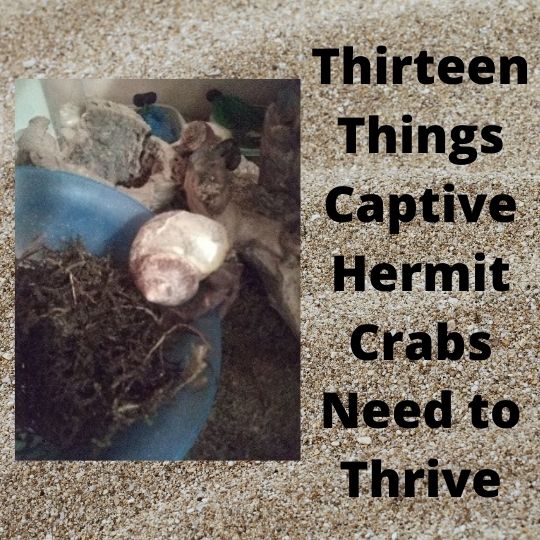- Sand at least 6 inches deep for molting.
- Humidity (suggest using a gauge to regulate it.)
- Fresh water pool with dechlorinated water
- Salt water pool deep enough for the crabs to fully submerge. Use ocean salt mix (like that used for salt water fish).
- Rocks or something else in the pool to ensure the smaller crabs can climb out.
- Hiding places like cork bark rounds or coconut houses.
- Wood or other things to climb on.
- At least 5 gallons of space per crab. For example at least a 20 gallon tank for 4 crabs. I currently have a 40 gallon tank for my 3 crabs, but I’m planning to upgrade to a 75 gallon in the future.
- Fresh food, such as fruits, vegetables, and nuts.
- Warmth. Their crabitat should be 75-80°F
- Unpainted/natural shells of progressing sizes
- A lid for the tank to keep the crabs in and the humidity up. 🙂
- Friends. Crabs are social.
In case you’re wondering why I chose this list, here’s why I’m interested in hermit crab care. 🙂
My first experience with hermit crabs was through pet sitting. I was shocked to learn that when people buy hermit crabs, they’re often not given complete information about the basic care of these pets. My pet sitting turned into an adoption because the owners legitimately had no idea about the conditions crabs need to survive or even that they could live longer than a few months to a year. (Crabs can actually live for decades.) Like many people, when they purchased the crabs they were sold a tiny container with minimal sand, shallow water dishes, and some dry hermit crab food. They were told that these items were pretty much all that was required for the new addition to their critter family. Because I knew nothing at all about crabs and didn’t want to accidentally do harm while pet sitting, I did some research online and found several sites that offered a lot of great information about them. Needless to say, when I talked to the crab owners, they were appalled that they hadn’t been give accurate information from the store where they bought the crabs. While sitting, I had bought some things recommended on the crab sites and we mutually decided that I could keep them. I’ve had them for four years, and while I’ve learned a lot about hermit crabs, I feel like I’m always learning more. As much as I love my hermit crabs, I wouldn’t recommend having them as pets unless you do a lot of research and are willing to make a commitment to them. I do my best, but let’s face it, a crabitat will never be the same as having miles of beach to live on. 🙂
If you’re interested in hermit crabs, I’ve found these sites to be helpful:
https://www.hermitcrabassociation.com/
https://crabstreetjournal.org/
https://www.hermitcrabpatch.com/category-s/174.htm
If you know of any other hermit crab sites, please let me know.
Don’t forget to stop by http://newthursday13.blogspot.com/ for more Thursday 13 posts!
Social

Crabs are social? Never had one as a pet but had a turtle once.
This is such important information! I’ve had hermit crabs, and later worked where they were sold. People had NO idea how much there was to their care. They have personalities too. I had one that would try to pull others out of their shells because “she” wanted it. I have a 30 gallon tank for them. People are so often ignorant of what any pet needs. Stores don’t help much, and even products. For instance, wheels show photos of Guinea pigs, yet wheels will damage a Guinea pig’s back.
Thank you, Lisa. You’re right that this happens with a lot of pets. Unless you do research on your own, you won’t always get accurate information. That’s good to know about Guinea pigs. I’ve thought about possibly getting guinea pigs in the future (they’re adorable), but right now I wouldn’t be able to provide the right space and care that they need.
That’s so true that hermit crabs have their own personalities! Some are shy and others not so much. LOL.
Hi Colleen. It’s surprising, but they really are. When mine are on the surface, they hang out in the same areas at the same time. It’s pretty cute. Turtles are lovely, too.